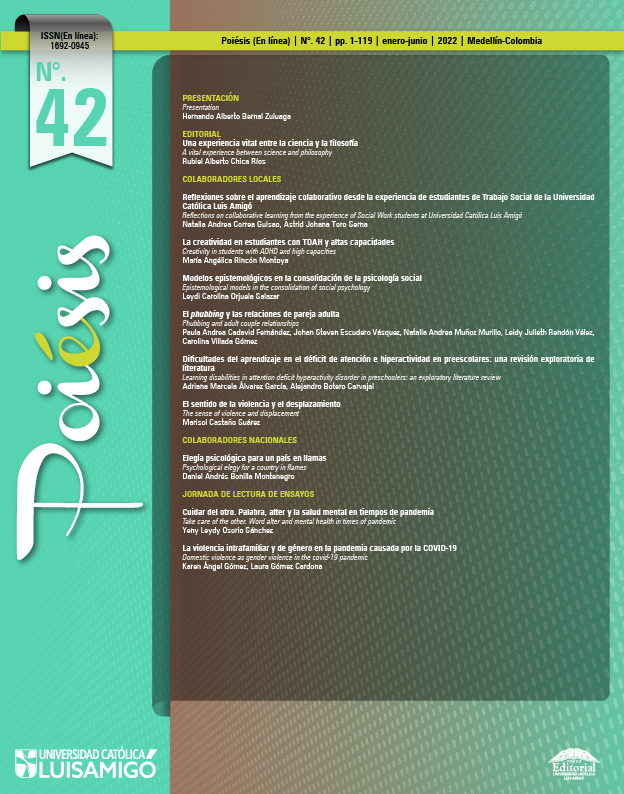Learning disabilities in attention deficit hyperactivity disorder in preschoolers: an exploratory literature review
DOI:
https://doi.org/10.21501/16920945.3848Keywords:
Attention deficit, ADHD diagnosis, Learning disabilities, Attention deficit hyperactivity disorder, Special education, PreschoolersAbstract
Background: Learning disabilities are the most common cause of school-age children receiving special education, however, the etiology of learning disabilities is still unknown. Therefore, we want to determine if a possible etiology of learning difficulties can be attention deficit hyperactivity disorder, because the latter is one of the most prevalent disorders in the educational context. For this reason, the purpose of the study is to determine what proportion of preschoolers who receive a diagnosis of attention deficit hyperactivity disorder can be expected to have learning difficulties. Methodology: exploratory literature review to identify all relevant literature in the Scopus, Science Direct, PubMed and Google Scholar databases, related to preschoolers between 2 and 5 years old, who receive a diagnosis of attention deficit hyperactivity disorder and who evaluate learning difficulties. The types of articles searched were: clinical trials, cohort studies, case-control studies, because they allow understanding the relationship between learning disabilities and patients diagnosed with attention deficit hyperactivity disorder (ADHD). The search strategy is represented in the PRISMA 2009 flow chart; the review took into account the SPIDER model. Results: no studies were found with the required methodological evidence, but observational studies were found. 4 of the 6 articles indicate that ADHD negatively affects learning; the remaining 2 were inconclusive, because ADHD symptoms can be confused with normal preschool behaviors. Conclusions: ADHD in preschoolers requires ethodological designs that allow data quality to assess the proportion of children between 2 and 5 years of age who will develop a learning disability. As well as the standardization of a diagnostic process for ADHD in preschoolers.
Downloads
References
American Psychiatric Association. (2016). DSM-V. Manual diagnóstico y estadístico de los trastornos mentales [Suplemento]. https://psychiatryonline.org/pb-assets/dsm/update/Spanish_DSM5Update2016.pdf
Blackman, J. A. (1999). Attention-deficit/hyperactivity disorder in preschoolers: Does it exist and should we treat it? Pediatric Clinics of North America, 46(5), 1011–1025. https://doi.org/10.1016/S0031-3955(05)70169-3
Galindo, G., Solovieva, Y., Machinskaya, R., & Quintanar, L. (2016). Atención selectiva visual en el procesamiento de letras: Un estudio comparativo. Ocnos. Revista de Estudios sobre Lectura, 15(1), 69–80. https://doi.org/10.18239/ocnos_2016.15.1.945
García, M.-A., Solovieva, Y., & Quintanar, L. (2013). El desarrollo de neoformaciones a través del juego y del cuento en niños preescolares. Culture and Education, 25(2), 183–198. https://doi.org/10.1174/113564013806631255
Huang, C. L.-C., Weng, S.-F., & Ho, C.-H. (2016). Gender ratios of administrative prevalence and incidence of attention-deficit/hyperactivity disorder (ADHD) across the lifespan: A nationwide population-based study in Taiwan. Psychiatry Research, 244, 382-387. https://doi.org/10.1016/j.psychres.2016.08.023
Jacobson, L. A., Schneider H., & Mahone, E. M. (2017). Preschool Inhibitory Control Predicts ADHD Group Status and Inhibitory Weakness in School. Archives of clinical neuropsychology: the official journal of the National Academy of Neuropsychologists, 33(8), 1006–1014. https://doi.org/10.1093/arclin/acx124
Li, J., Olsen, J., Vestergaard, M., & Obel, C. (2010). Attention-deficit/hyperactivity disorder in the offspring following prenatal maternal bereavement: a nationwide follow-up study in Denmark. European child & Adolescent Psychiatry, 19(10), 747–753. https://doi.org/10.1007/s00787-010-0113-9
Llanos Lizcano, L. J., García Ruiz, D. J., González Torres, H. J., & Puentes Rozo, P. (2019). Trastorno por déficit de atención e hiperactividad (TDAH) en niños escolarizados de 6 a 17 años. Pediatría Atención Primaria, 21(83), e101-e108. https://hdl.handle.net/20.500.12442/3954
Marín-Méndez, J. J., Borra-Ruiz, M. C., Álvarez-Gómez M. J., & Soutullo Esperón, C. (2017). Psychomotor development and learning difficulties in preschool children with probable attention deficit hyperactivity disorder: An epidemiological study in Navarre and La Rioja. Neurología, 32(8), 487–493. https://doi.org/10.1016/j.nrl.2016.02.009
Merrell, C., & Tymms, P. B. (2001). Inattention, hyperactivity and impulsiveness: their impact on academic achievement and progress. British Journal of Educational Psychology, 71(1), 43–56. https://doi.org/10.1348/000709901158389
Methley, A. M., Campbell, S., Chew-Graham, C., McNally, R., & Cheraghi-Sohi, S. (2014). PICO, PICOS and SPIDER: a comparison study of specificity and sensitivity in three search tools for qualitative systematic reviews. BMC Health Services Research, 14, 579. https://doi. org/10.1186/s12913-014-0579-0
Pires, T.d.O., da Silva, C.M.F.P., & de Assis, S.G. (2013). Association between family environment and attention deficit hyperactivity disorder in children – mothers’ and teachers’ views. BMC Psychiatry, 13, 215–230. https://doi.org/10.1186/1471-244X-13-215
Shaw, P., Eckstrand, K., Sharp, W., Blumenthal, J., Lerch, J. P., Greenstein, D., Clasen, L., Evans, A., Giedd, J., & Rapport, J. L. (2007). Attention-deficit/hyperactivity disorder is characterized by a delay in cortical maturation. Proceedings of the National Academy of Sciences of the United States of America, 104(49), 19649-19654. https://doi.org/10.1073/pnas.0707741104
Schuch, V., Utsumi, D. A., Costa, T. V., Kulikowski, L. D., & Muszkat, M. (2015). Attention deficit hyperactivity disorderin the light of the epigenetic paradigm. Front in Psychiatry, 6, 126. https://doi.org/10.3389/fpsyt.2015.00126
Schworm, R. W., & Birnbaum, R. (1989). Symptom expression in hyperactive children: an analysis of observations. Journal of Learning Disabilities, 22(1), 35-45. https://doi.org/10.1177/002221948902200107
Spira, E. G., & Fischel, J. E. (2005). The impact of preschool inattention, hyperactivity, and impulsivity on social and academic development: a review. Journal of Child Psychology and Psychiatry, and allied disciplines, 46(7), 755–773. https://doi.org/10.1111/j.1469-7610.2005.01466.x
Webb, E. (2013). Poverty, maltreatment and attention deficit hyperactivity disorder. Archives of Disease in Childhood, 98(6), 397–400. http://dx.doi.org/10.1136/archdischild-2012-303578
Williamson, J. M., & Lyons, D. A. (2018). Myelin Dynamics Throughout Life: An Ever-Changing Landscape? Frontiers in Cellular Neuroscience, 12, 424. https://doi.org/10.3389/fncel.2018.00424
Wu, Y.H., Gau, S.S., Lo, Y. C., & Tseng, W.Y. (2014). White matter tract integ-rity of frontostriatal circuit in attention deficit hyperactivity disorder: association with attention performance and symptoms. Human Brain Mapping, 35(1), 199–212. https://doi.org/10.1002/hbm.22169
Published
How to Cite
Issue
Section
License
Copyright (c) 2022 Poiésis

This work is licensed under a Creative Commons Attribution-NonCommercial-NoDerivatives 4.0 International License.
La revista y los textos individuales que en esta se divulgan están protegidos por las leyes de copyright y por los términos y condiciones de la Licencia Creative Commons Atribución-No Comercial- 4.0 Internacional. Permisos que vayan más allá de lo cubierto por esta licencia pueden encontrarse en http://www.funlam.edu.co/modules/fondoeditorial/ Derechos de autor.











